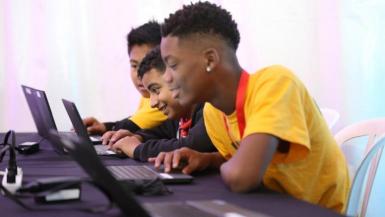
Problem solving and analytic skills learned through STEM activities is a great foundation for critical thinking skills needed in the 21st century workforce. Gaining confidence at a young age to persevere through challenges and problem solve by iterative progress will not only create a platform of curiosity and exploration in young children, but will prepare them well for the future.

Critical Thinking skills encourage kids to put outcomes or result in perspective. In a society where answers are instantly ready with the click of a button, critical thinking encourages putting challenging situations in context by encouraging the following paradigm shifts:
– Successful Failure. Not everything works the first time. This is especially true in STEM fields. Thomas Edison said, “I have not failed. I’ve just found 10,000 ways that won’t work.” Successful failure is a paradigm that encourages examination of outcomes or results that are different from what was expected. The paradigm of successful failure encourages a perspective of celebrating what was learned through the perceived failure, and building upon that insight.
– Challenging Opportunities. Every challenge is an opportunity to learn more than we knew before. Realizing that not every answer to a challenge is readily available, encourages kids to explore possible solutions. Critical thinking skills give kids the momentum to ask ‘why’ and ‘what if’ and the framework by which to discover their own answers.
– Complementary Strengths. Everyone has something they are good at. Everyone also has things they are not so good at. Recognizing the value that strengths in different skills or knowledge can bear in accelerating innovate solutions is a great skill to develop at a young age and a great paradigm to use when navigating solutions to challenging STEM projects.
– Collaborative Dissention. Challenging problems have challenging solutions with many different paths to success. STEM activities embody the fact that critical thinking requires brainstorming possibilities and trying them out. Brainstorming and thinking outside the box is best facilitated by reaching out to those who have different ideas and building upon the insights that those different ideas provide. Collaborating on the different possibilities sparks innovation in solutions.
If you have critical thinking skills, you are not only highly employable by a multitude of businesses…but are highly sought after. Despite what common perception might lead one to think, critical thinking skills are not developed just by staring at a screen in a dark room. The best critical thinking skills are developed by being challenged through projects and by others with different strengths and perspectives. Employers solve challenges with people working together and seeking solutions that are truly creative and innovative.
STEM education will build your child’s confidence today and will prepare them for the workforce of tomorrow. Critical thinking skills are hard to learn at any age and are skills that your students will continue to develop well into any career. But a strong foundation that supports learning from failures and seeking insights from those with differing perspectives creates an innovative mindset, and that is what Employers are looking for. By encouraging your child to build critical thinking skills, you will give your student the skills they need today to succeed well into the future.